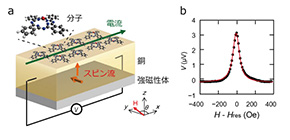
Coat of paint on a Cu surface facilitates efficient spin-to-charge current conversion
Researchers from the University of Tokyo, Osaka University, RIKEN, and Kanazawa University demonstrated spin-to-charge (S-C) current conversion on a copper surface covered with a single layer of molecules of phthalocyanine, which is frequently used in paints and dyes.
Spintronics, or spin electronics, is a new field of research exploiting the electron spins and magnetic moments of materials, in addition to using the electronic charge, in solid-state devices. In spintronics, technology to generate and detect spin currents in materials is especially important. The recent discovery of charge-to-spin (C–S) current conversion and spin-to-charge (S–C) current conversion at metal/oxide interfaces is drawing attention.
This research group focused on organic molecules, which have a higher degree of design freedom than inorganic molecules but have not yet been fully explored. The researchers injected a spin current into an interface between a metal (Cu) and organic lead(II) phthalocyanine (PbPc) with a spin pumping method, which caused a voltage signal, demonstrating an efficient spin-to-charge current conversion at the interface.
In addition, in order to find conditions for the most effective conversion, the group fabricated samples with different thicknesses of the PbPc layer, measuring changes in the inverse Edelstein effect voltage signal (S-C conversion). As a result, a voltage signal caused by S-C conversion became the largest value at the metal surface covered with a single molecular layer (ML).
S-C conversion efficiency achieved by this device was equivalent to that of devices made with inorganic metallic materials, such as platinum or bismuth. Moreover, analysis of the state of electron spin using a large-scale first principle calculation with a Fujitsu supercomputer K computer showed that S–C conversion phenomena was induced at a PbPc/Cu interface by the spin pumping method.
This group’s achievements will lead to the development of new electronic spin devices by making use of the high degree of design freedom of these molecules.
Figure 1
Figure 2
Figure 3
The article “Realization of spin dependent functionality by covering a metal surface with a single layer of molecules,” was published in Nano Letters at DOI: https://doi.org/ 10.1021/acs.nanolett.9b02619 .
Related links
